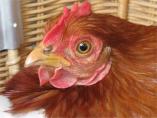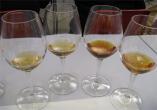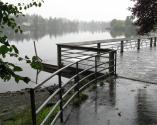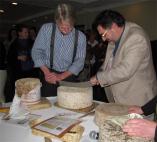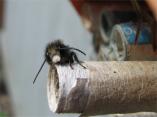Today when the UK is again struggling with Foot & Mouth disease, I have retreated to the couch where I have been reading a terrific book, Last Chance to Eat, by a Canadian (via England) food writer, Gina Mallet.
Although it’s full of interesting facts, figures, anecdotes and recipes, I’ve found (thanks to this year’s education) two factual errors. One of the errors – that sent me running for my cheese technology notes – has to do with Parmigiano Reggiano cheese, which she says can only, according to the rules of the “Dominazione di Origine Controllata… be made only between 15 April and 11 November, when the cattle – producers of a quality milk called Pezzato Rosso – are grazing on fresh grass rather than eating silage.”
What is wrong with this statement is: there is no date restriction on production of Parmigiano-Reggiano cheese (it’s made year round); and the cattle are not allowed to eat silage or to graze on fresh grass because of the risk they might eat wet grass that has the same fermentative effect as silage. Fermented feed puts the milk at risk of developing heat-resistant bacteria, butyric clostridia, which causes cracks and holes in the cheese paste, making the cheese unsaleable as Parmigiano-Reggiano. (The cows producing milk for Parmigiano-Reggiano are, for this reason, not free range; they spend their lives in cow sheds.)
The regulations actually specify no silage, to preserve the safety of the cheese, the reliability of the ripening process, and the purity of the flavour. The rules are laid out and administered by the Consorzio del Formaggio Parmigiano-Reggiano.
The Pezzata Rossa she mentions is a traditional breed of cow once widely used for Parmigiano-Reggiano production, and is still used for a more exclusive product, Parmigiano-Reggiano delle Vacche Rosse. But since there is no restriction on the type of cow used for Parmigiano-Reggiano, dairies use higher yield breeds like Friesians.
The other error I came upon is to do with BSE, mad cow disease and its human incarnation, variant CJD, which Mallet attributes to 109 sufferers identified in 1993 having eaten more veal than others. But I remembered it being reported that the 10 sufferers identified in 1996 had eaten more beef (except for the one case who was vegetarian, presumably) – the highly processed kind, found in pre-fab meat pies, frozen burgers and the like, where presumably there is more animal byproduct than you’d normally be consuming.
And according to a WHO fact sheet on the subject, “infectivity is mainly found in the brain and spinal cord of clinically ill animals over two years of age.”
Anyway, the latest statistics for world-wide infection show that there have been a world-wide total of 201 infected through to July 2007. So I’m not sure where the figure of 109 UK cases came from; perhaps there was some early confusion between sporadic CJD and variant CJD.
Anyway it led me into some interesting reading around veal, including a piece by the rather fierce Guardian food writer, Joanna Blythman, which is a good summary of the ‘why to eat more veal’ argument – which hinges on the biological fact of dairy, namely that cows must get pregnant and give birth in order to lactate and give us milk and dairy products, resulting in a living byproduct, namely veal. Which is a point most of us, in our blissful detachment from the source of our food, have never considered, in our haste to condemn veal crates, which are banned in Europe from this year in any case.
An amusing animation about dairy farming in the US…
And finally, if you liked The Matrix, you’ll love The Meatrix.
